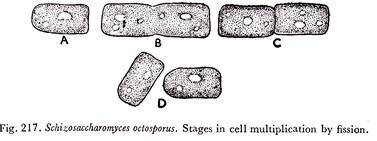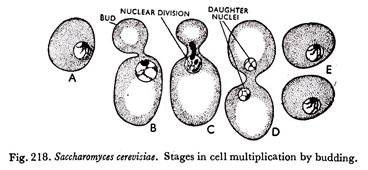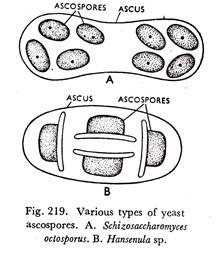ADVERTISEMENTS:
In this article we will discuss about the reproduction in yeast. This will also help to draw the structure and diagram of reproduction in endomycetales.
Asexual Reproduction:
Yeasts reproduce asexually either by fission or by budding. Depending on this character they are grouped as fission yeasts, Schizosaccharomyces and budding yeasts, Zygosaccharomyces.
ADVERTISEMENTS:
During reproduction of fission yeasts the parent cell elongates (Fig. 217A & B), the nucleus divides into two daughter nuclei, and gradually a transverse partition wall is laid down somewhat near the middle starting from periphery to the centre dividing the mother cell into two daughter cells (Fig. 217 C & D).
The two daughter cells so formed may remain together for some time and begin to divide again or they may separate soon and then divide.
Budding yeasts are rather common than the fission yeasts. At the commencement of budding a small portion of the cell wall, usually near the end, softens. The nucleus of the mother, cell, according to- some, divides mitotically. One of the two daughter nuclei migrates into the enlarging bud (Fig. 218G & D). The bud grows until it attains the size of the mother cell.
ADVERTISEMENTS:
The daughter cell then becomes separated from the mother cell and the process may be repeated indefinitely (Fig. 218E). Others suggest that when the yeast cell buds its nucleus appears to divide by constriction and the nuclear envelope does not break down.
The cytoplasmic connection is closed by the lying down of wall material. Eventually the bud separates from the parent cell leaving a bud scar (Fig. 215). Quite often the daughter cell also starts producing bud before being abstricted from the mother cell and the process may be repeated giving rise to chains or groups of yeast cells.
In this way a large number of buds are developed without being detached from one another resulting in the formation of branched or unbranched chains of cells constituting the pseudomycelium. The cells in chains for pseudomycelium are loosely joined together. Sooner or later, however, the chains break into their constituent cells.
In some yeasts when the food in the surrounding medium is exhausted, or when there is danger of desiccation, spores are formed from the mother cells. In the process of spore formation the protoplasm divides, usually into four portions, each of which becomes surrounded with a comparatively thick wall. Thus four thick-walled spores known as endospores are formed.
After some time the spores are liberated. By virtue of their thick walls the spores can remain alive under adverse conditions. On germination the spores bud and give rise to chains of cells. Wei ten (1914) challenged the view that starvation condition is essential for sporulation.
Working with Saccharomyces cerevisiae, he found that on prune extract agar, yeasts sporulate well. Even colonies embedded in the agar sporulated as well as those on the surface.
Sexual Reproduction:
It takes place by the union of two cells more often similar in size but sometimes they may be dissimilar in appearance, and by the development of short protuberances which unite to form a conjugation tube. This is followed by the dissolution of intervening walls and nuclear fusion which takes place in the conjugation tube.
ADVERTISEMENTS:
The subsequent stages’ are extremely variable and are discussed separately. The copulating pair of cells may be vegetative cells or ascospores. Often copulation occurs between a mother cell and its bud. This is known as pedogamy and is observed in zygosaccharomyces chevalieri. Yeasts may be homothallic or heterothallic.
Sexual reproduction of yeasts was first clearly recognized by Guillermond (1901-1902). He demonstrated copulation of yeast nuclei and the subsequent stages leading to the ascospore formation. The number and shape of ascospores are variable (Fig. 219). In 1940 Guillermond showed that three life cycle patterns are distinguishable among yeasts.
ADVERTISEMENTS:
They are:
I. Haplobiontic Life Cycle:
This is exhibited by Schizosaccharomyces octosporus which is homothallic. Here the haploid stage (haplophase) is very elaborate. Whereas, the diploid stage (diplophase) is very short being confined to the zygote cell only. Meiosis of the diploid zygotic nucleus takes place immediately after karyogamy. The somatic cells are haploid and elongated. They divide by fission forming daughter cells.
Any somatic cell is a potential gametangium. During sexual reproduction two cells come in contact.
ADVERTISEMENTS:
A beak-like protuberance develops from each conjugating cell at the point of Contact. A continuous passage is developed by the dissolution of intervening walls at the point of contact where the two nuclei migrate. The passage between the two cells enlarges forming a conjugation tube, where karyogamy takes place. Gradually the two cells along with the conjugation tube form the zygote cell.
The zygote cell ultimately develops into an ascus. The diploid zygotic nucleus undergoes three divisions, of which the first one is meiotic, producing eight haploid nuclei. Each nucleus with cytoplasjn develops into an ascospore and the ascus contains eight ascospores. The ascospores liberate by the breaking down of the ascus wall. They now behave as somatic cells. Life cycle is presented in Figure 220.
II. Diplobiontic Life Cycle:
ADVERTISEMENTS:
This is exemplified by Saccharomycodes ludwigii. Here the diploid somatic stage is long and the haploid stage is very short. The diploid somatic cells produce buds which eventually enlarge to function as asci. The diploid nucleus divides meiotically forming four haploid nuclei around which four ascospores are developed.
The ascospores remain confined in the ascus and copulate there forming two diploid cells. Each diploid cell germinates by a germ tube which pushes out through the ascus wall ultimately forming a tubular structure. This tubular structure behaves as a sprout mycelium from which diploid cells are produced by budding. Thus, the haploid stage is represented by the ascospores only. f Life cycle is presented in Figure 221.
III. Haplo-Diplobiontic Life Cycle:
This is exhibited by Saccharomyces cetevisiae. In this type of life cycle both haploid and diploid phases are equally well represented constituting somewhat an alternation of generations. Two haploid cells copulate forming a diploid cell. The diploid cell multiplies by budding producing large number of diploid cells.
Eventually, each diploid cell behaves as an ascus bearing four ascospores and meiosis takes place during the development of ascospores.
ADVERTISEMENTS:
The ascospores on being liberated from the ascus multiply by budding producing haploid cells. Thanks to the investigations of Winge who worked out in detail the life cycle of Saccharomyces cerevisiae. It is evident that in this life cycle there are two distinct stages, the diploid stage and the haploid stage which alternate in cyclic order.
The vegetative cells may be both haploid and diploid reproducing asexually by budding. Nuclear cycle of Saccharomyces cerevisiae was worked out in detail by Guillermond. He observed that karyogamy does not always immediately follow plasmogamy. A dikaryotic condition may sometime be interpolated between plasmogamy and karyogamy.
Dikaryotic buds are formed from the dikaryotic cells simultaneously along with the conjugate nuclear division. In these dikaryotic buds, nuclear fusion occurs. Guillermond has compared this with the dikaryophase of other fungi.
Renaud confirmed Guillermond’s findings and, in addition, pointed out that some dikaryotic cells produce not-only dikaryotic buds, but also uninucleate buds which may later copulate and produce diploid cells. Life cycle is presented in Figure 222.
Yeast Genetics:
ADVERTISEMENTS:
Beginning in 1935 Winge and Lausten extended our knowledge of sexuality in the yeasts.
Later, the Lindegrens (1943) have demonstrated how yeast may be used as tool for genetical studies, some of the aspects are:
(1) Ascospores can be cultured to study segregation of characters;
(2) Dominant, recessive, and lethal characters can very well be studied by simple cultural technique;
(3) New strains can be developed by making hybrids of commercial importance;
(4) Inbreeding degeneration, legitimate and illegitimate pairing, instability of the mating type alleles and similar other fundamental studies can be performed within a short period of time applying various cultural techniques.
Some Indian species of Yeast Genetics:
Saccharomyces apiculatns Rees: S. cerevisiae Meyen; S.fructuum Lodder and Kreger van Rij; S. steineri Lodder and Kreger van Rij; Schizosaccharomyces octosporus Beijerinck.





